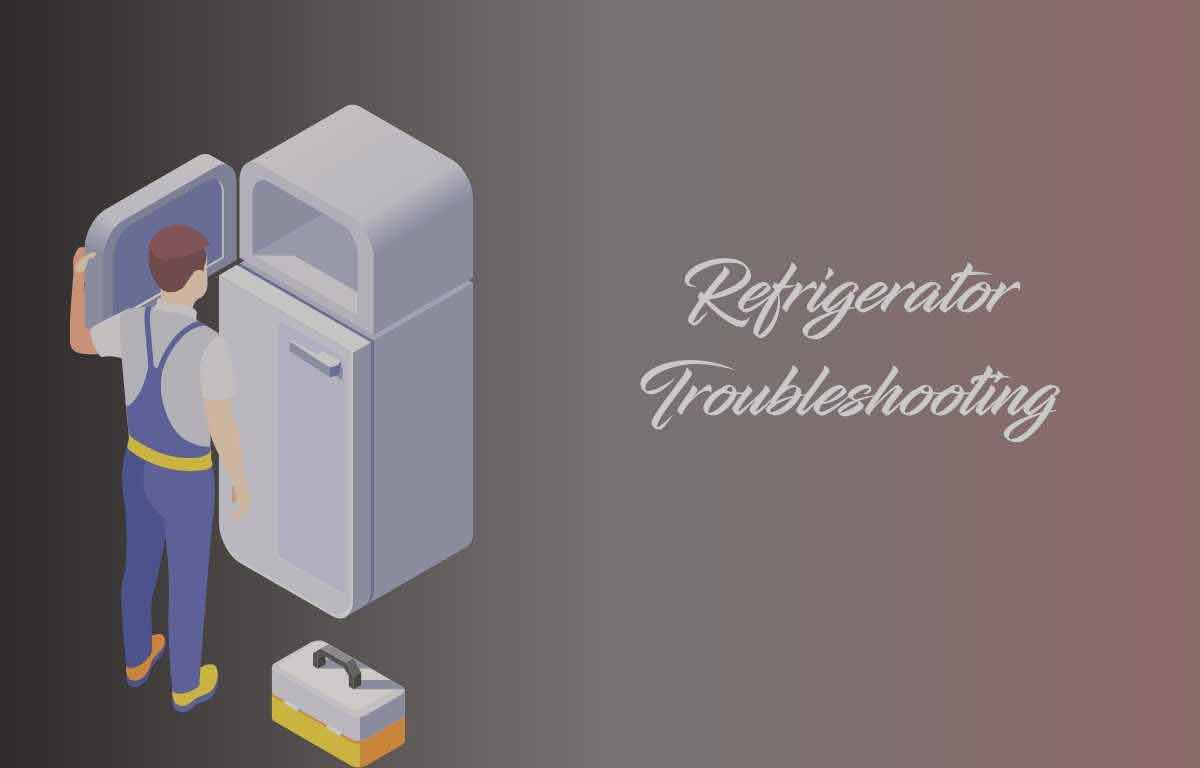Refrigerator Troubleshooting includes conducting comprehensive examinations of various systems and components to identify the root of the issue and put appropriate fixes in place.
The power supply should be checked, temperature settings should be correct, condenser coils should be checked for debris or obstructions, door seals should be checked for leaks, and strange noises or odours should be investigated.
Refrigerator Troubleshooting
These procedures will help you identify and resolve many typical refrigerator issues, ensuring that your appliance runs effectively and preserves the freshness of your food.
- Ensure that the refrigerator is safely plugged in.
- Verify whether a fuse or a circuit breaker has blown.
- Check the current in the outlet.
- Check for damage to the electrical cord.
- If an extension cord is being used, get rid of it.
- Verify the voltage at the outlet.

Refrigerator Not Working
Here are some easy actions to do if your refrigerator is not working.
- Verify that the refrigerator is connected to a functioning electrical outlet properly
- Check to make sure the freezer and refrigerator’s temperature controls are adjusted properly.
- To determine whether the circuit that delivers power to the refrigerator has tripped a breaker or burst a fuse
- Look for any signs of debris or dust on the condenser coils, which are often found at the back or bottom of the refrigerator.
- Damaged seals should be replaced or, if necessary, adjusted.
Note: It is advised to call a certified appliance repair professional to identify and remedy the problem if none of these measures succeed in fixing it.
Refrigerator Not Cooling
A refrigerator that doesn’t cool down can be caused by a number of things, including
- Unclean condenser coils
- Faulty installation and poor ventilation
- Defective or soiled gasket seals
- Unorganized food storage
- Location of the appliance and broken interior components.
Our refrigerator may have problems even with the condenser coils, evaporator fan, thermostat, or compressor if it is operating but not cooling. To identify and fix the exact issue, a professional technician should be consulted.
Refrigerator Ice Maker Not Working
Here are some measures you may do to fix the ice maker if it is not functioning in your refrigerator.
- Ensure that the ice maker. it is switched to the “on” position.
- In order to ensure that the ice maker is operating properly, remove any extra ice and remove any blockages.
- Water flow to the ice maker may be hampered by a clogged filter. As directed change the water filter.
- Make sure the freezer is set at a low enough temperature to produce ice. Typically, a temperature of 0°F (-18°C) is optimum.
- Once the ice maker has finished its cycle, press the reset button.
Refrigerator Water filter Replacement
The general procedures for replacing an ice or water filter set up in the refrigerator’s water filter line are listed below.
- Unplug the refrigerator after removing it.
- Remove the filter’s connection to the water supply.
- To remove any fittings, pull the supply lines away from the filter.
- The new filter should be screwed or connected to the fittings.
- The water supply pipes should be reconnected to the supply valve.
- Turn on the water.
- Connect the new filter’s outlet side to the refrigerator’s water line.
- Reopen the water valve.
- For any leaks, look.
Refrigerator Water Dispenser Not Dispensing Water
Here are some measures you can do to fix the problem if the refrigerator Dispensing Water:
- Examine the water supply.
- Look for a locked vending machine.
- Look over the water inlet valve.
- Cleanse the water line of air.
- Examine the dispenser control board.
- Check the pipe for the water dispenser.
Refrigerator Water Dispenser Is Leaking
- Make that the water supply valve and the connections for the water line at the back of the refrigerator are well fastened.
- Check the water line for any obvious cracks, leaks or damage.
- Make sure the water filter is installed properly if your refrigerator has one.
- Take the filter out and check it for damage or alignment issues. If necessary, swap it out.
Note: If you are unsure of how to proceed or are unable to fix the problem, it is crucial that you study the refrigerator’s user handbook. If necessary, they can arrange a repair or offer more advice.
Refrigerator Won’t Stop Running
The temperature of the refrigerator may rise if the coils are covered in dust and filth because the refrigerant may not cool correctly. As a result, the compressor will operate nonstop while attempting to chill the inside.
- To get rid of dust, filth, and debris, brush the coils using an appliance brush.
- With the brush attachment, hoover any leftover dirt on and around the coils.
- Replace the access panel or grille.
- Restore power to the refrigerator.
Refrigerator Noisy
Six Steps to Fix a Refrigerator Making Loud Noise
- Try to hear the Source. Is the refrigerator’s inside, bottom, or rear making noise
- The Drain Pan must be secured.
- Listen for a faulty defrost timer and look for one.
- Condenser fan cleaning and inspection.
- Examine the evaporator fan.
- Check to see if the noise is coming from a compressor in a refrigerator.
Refrigerator Lights Not Working
If your refrigerator’s light isn’t working, you have a few options.
- Verify that the fuse or circuit breaker in charge of the refrigerator’s power is not blown or tripped.
- Check to see if the LED or incandescent lights in the refrigerator are burned out or loose.
- To check if the door switch is working properly, locate it (it’s typically near the top of the refrigerator or freezer section). Press it.
- Look closely at the connections and wiring around the lights and switches.